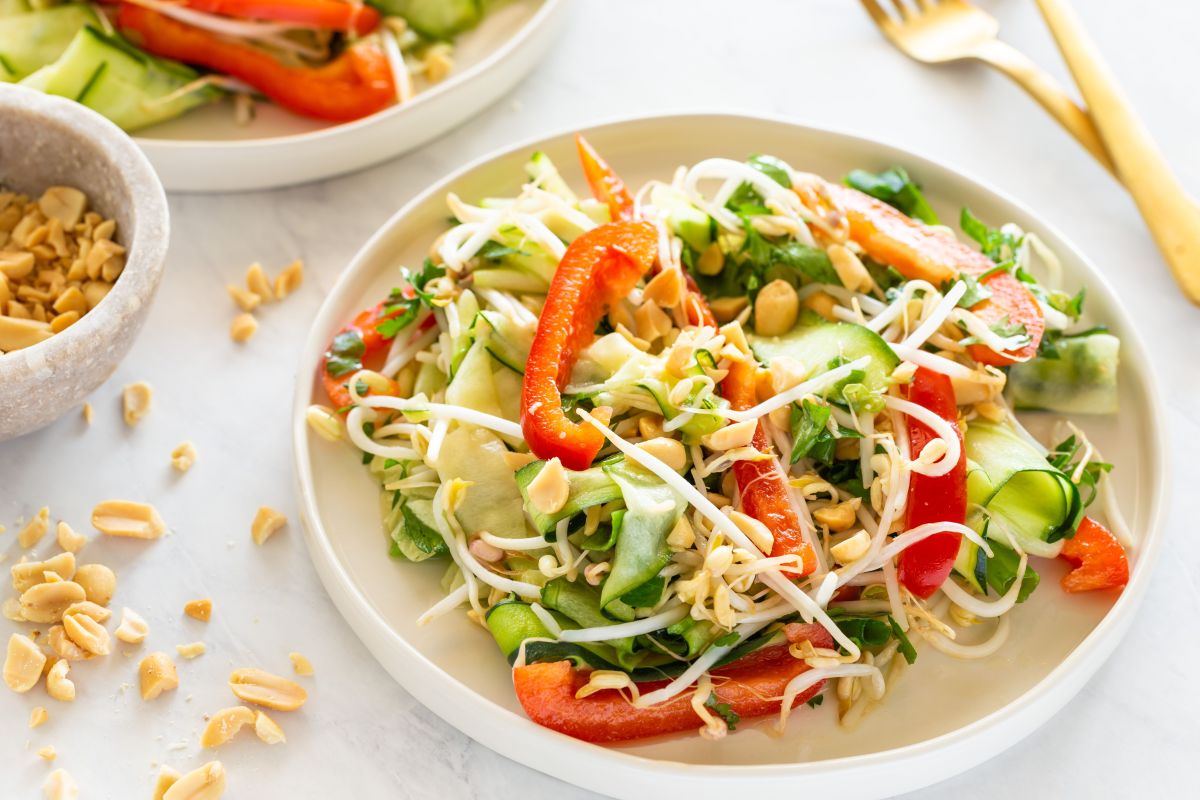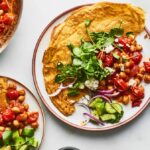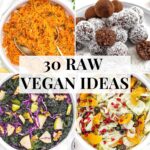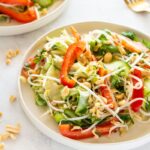Embark on a vibrant journey into the world of raw veganism! Imagine a diet bursting with the vivid colors of fresh fruits and vegetables, a symphony of textures from crunchy salads to creamy nut-based desserts. This isn’t about deprivation; it’s about embracing a lifestyle that nourishes your body and awakens your senses. We’ll guide you through the fundamentals of a raw vegan diet, providing easy-to-follow recipes and practical tips to make this transformative experience both enjoyable and sustainable. Discover how simple it can be to cultivate a healthier, more vibrant you.
This comprehensive guide demystifies the raw vegan lifestyle, addressing common concerns and offering practical solutions. From understanding the nutritional benefits and potential challenges to mastering simple yet delicious recipes, we’ll equip you with the knowledge and confidence to seamlessly integrate raw foods into your daily routine. We’ll cover everything from creating balanced meal plans to selecting the right ingredients and mastering essential techniques for preserving freshness and maximizing nutritional value. Prepare to be inspired by the beauty and simplicity of raw vegan cuisine.
Understanding the Raw Vegan Diet
Embarking on a raw vegan diet involves a significant shift in dietary habits, focusing solely on unprocessed plant-based foods that haven’t been heated above 115°F (46°C). This approach emphasizes consuming foods in their natural state, preserving their enzymes and vital nutrients. Understanding its principles, benefits, and potential challenges is crucial for a successful transition.
The raw vegan diet is based on the belief that heating food destroys essential enzymes and reduces its nutritional value. Adherents prioritize whole, unprocessed fruits, vegetables, nuts, seeds, and sprouts. Preparation methods are limited to juicing, blending, dehydrating, and minimal chopping. This approach aims to maximize nutrient intake and promote optimal health through a vibrant, plant-based lifestyle.
Principles and Benefits of a Raw Vegan Diet
The core principle revolves around consuming foods in their natural, uncooked form. This approach is believed to maximize nutrient retention, enhance digestion, and provide an abundance of vitamins, minerals, and antioxidants. Potential benefits often cited include improved digestion, increased energy levels, weight management, and a reduction in inflammation. Many proponents report clearer skin, improved sleep, and a heightened sense of well-being. However, it’s important to remember that these benefits are anecdotal and scientific evidence supporting these claims is still developing. A well-planned raw vegan diet can provide a rich source of fiber, supporting healthy gut function and regular bowel movements. The high water content in many raw foods contributes to hydration, which is crucial for overall health.
Nutritional Considerations and Potential Challenges
While offering potential advantages, the raw vegan diet also presents nutritional challenges. A carefully planned approach is crucial to ensure adequate intake of essential nutrients, particularly vitamin B12, vitamin D, calcium, iron, and omega-3 fatty acids. These nutrients are not readily available in sufficient quantities from plant-based sources alone, and supplementation might be necessary. Furthermore, the restrictive nature of the diet can lead to social difficulties and meal preparation can be time-consuming. The potential for nutrient deficiencies underscores the importance of careful meal planning and potentially consulting a registered dietitian or healthcare professional experienced in vegan nutrition. Ignoring this aspect can lead to fatigue, weakness, and other health problems.
Macro and Micronutrient Comparison
A balanced diet is essential, and comparing macronutrient and micronutrient intake between a standard diet and a raw vegan diet highlights key differences. While a standard diet can vary greatly, this table offers a generalized comparison to illustrate potential disparities. Individual results will vary greatly depending on the specific foods consumed in each diet. This table should not be considered medical advice. Consult a registered dietitian for personalized dietary guidance.
| Nutrient | Raw Vegan Intake (Example Values) | Standard Diet Intake (Example Values) | Difference |
|---|---|---|---|
| Protein (grams/day) | 50-70 | 70-100 | -20 to +30 |
| Carbohydrates (grams/day) | 150-250 | 200-300 | -50 to +100 |
| Fat (grams/day) | 30-50 | 50-80 | -20 to +30 |
| Vitamin B12 (mcg/day) | Often deficient, requires supplementation | Usually sufficient | Significant difference, often requiring supplementation |
| Iron (mg/day) | Can be low, bioavailability impacted by other nutrients | Usually sufficient | Potentially significant difference, requiring careful meal planning |
| Calcium (mg/day) | Can be low, bioavailability impacted by other nutrients | Usually sufficient | Potentially significant difference, requiring careful meal planning |
Planning Your Raw Vegan Meal Plan
Embarking on a raw vegan journey requires careful planning to ensure you’re meeting your nutritional needs and enjoying delicious, vibrant meals. A well-structured meal plan provides variety, prevents nutritional deficiencies, and keeps you motivated throughout your dietary shift. This section will guide you through creating your own personalized raw vegan meal plan, outlining essential ingredients, equipment, and helpful meal prepping techniques.
A Sample 7-Day Raw Vegan Meal Plan
This sample plan provides a balanced intake of fruits, vegetables, nuts, and seeds. Remember to adjust portion sizes based on your individual caloric needs and activity levels. Variety is key – feel free to substitute similar ingredients to keep things interesting.
| Day | Breakfast | Lunch | Dinner |
|---|---|---|---|
| Monday | Mango and papaya smoothie with a sprinkle of chia seeds | Large mixed green salad with avocado, cucumber, and sunflower seeds, dressed with a lemon-tahini vinaigrette | Zucchini noodles with a vibrant tomato and basil sauce, topped with hemp seeds |
| Tuesday | Overnight oats soaked in almond milk with berries and shredded coconut | Rainbow veggie wraps with hummus and sprouts | Raw Pad Thai made with zucchini noodles, carrots, and a cashew-based sauce |
| Wednesday | Pineapple and spinach smoothie with a touch of ginger | Quinoa salad with chopped bell peppers, red onion, and a lime dressing | Sweet potato and black bean burgers (made without cooking) on a bed of greens |
| Thursday | Berry parfait layered with coconut yogurt and granola (ensure granola is raw) | Avocado toast on sprouted grain bread with everything bagel seasoning | Raw lasagna with layers of zucchini, marinara sauce (raw), and cashew cheese |
| Friday | Green smoothie with kale, banana, and spirulina | Large salad with roasted sweet potatoes (dehydrated, not roasted in oven), pecans, and a maple-mustard dressing | Dehydrated veggie and lentil patties served with a side of raw coleslaw |
| Saturday | Acai bowl topped with fresh fruit and nuts | Leftovers from Friday’s dinner | Raw pizza with a zucchini crust, tomato sauce, and various vegetables |
| Sunday | Fruit salad with a variety of seasonal fruits | Leftovers from Saturday’s dinner | A large vibrant salad with a variety of colorful vegetables, nuts, and seeds |
Essential Ingredients and Equipment
Stocking your kitchen with the right ingredients and equipment is crucial for successful raw vegan meal preparation. Having these items readily available will streamline the process and encourage consistent adherence to your diet.
- Fruits and Vegetables: A wide variety of seasonal produce forms the backbone of a raw vegan diet. Think leafy greens, colorful vegetables, and a range of fruits for sweetness and nutrients.
- Nuts and Seeds: These provide healthy fats, protein, and fiber. Almonds, cashews, chia seeds, sunflower seeds, and flaxseeds are excellent choices.
- Sprouts: These are packed with nutrients and easily incorporated into salads, wraps, and other dishes.
- Dried Fruits (in moderation): Dates, raisins, and figs add sweetness and energy.
- Superfoods (optional): Spirulina, chlorella, and maca powder can boost your nutrient intake.
- High-quality olive oil and avocado oil: These provide healthy fats for dressings and other uses.
- High-speed blender: Essential for smoothies, soups, and sauces.
- Food processor: Useful for chopping vegetables, making nut butters, and preparing various dips.
- Dehydrator: Allows you to create raw crackers, veggie chips, and other dehydrated treats.
- Spiralizer or vegetable peeler: For making zucchini noodles and other vegetable ribbons.
- Good quality knives and cutting board: For efficient and safe food preparation.
Meal Prepping and Storage Tips
Proper meal prepping and storage are vital for maintaining the freshness and nutritional value of raw vegan foods. These tips will help you stay organized and make the most of your ingredients.
- Wash and chop vegetables in advance: Store them in airtight containers in the refrigerator to maintain their crispness.
- Prepare large batches of dressings and sauces: These can be stored in the refrigerator for several days.
- Make smoothie packs: Portion out fruits and vegetables into freezer bags for quick and easy smoothie preparation.
- Utilize your dehydrator: Dehydrating vegetables and fruits extends their shelf life and allows for snacking on delicious, nutrient-dense chips.
- Store raw foods properly: Avoid cross-contamination and always refrigerate perishable items promptly.
Transitioning to a Raw Vegan Diet

Embarking on a raw vegan journey is a significant lifestyle change, and understanding the potential challenges and implementing a smooth transition is crucial for long-term success. Many find the initial shift demanding, but with careful planning and a gradual approach, the rewards of vibrant health and increased energy can be readily achieved.
Successfully transitioning to a raw vegan diet requires a mindful approach, acknowledging that individual experiences vary. The key is to prioritize a gradual integration of raw foods, rather than a sudden, drastic overhaul. This minimizes the risk of nutrient deficiencies and allows your body to adapt comfortably to the new dietary regime.
Common Challenges and Solutions
The shift to a raw vegan diet can present several hurdles. Digestive discomfort, such as bloating or gas, is common initially, as the gut microbiome adjusts to the high fiber content. Nutrient deficiencies, particularly vitamin B12 and iron, are also potential concerns if not properly addressed. Finally, social situations and the availability of raw vegan options can pose challenges.
To mitigate digestive issues, start slowly, incorporating raw foods gradually into your existing diet. Increase your water intake to aid digestion and consider introducing probiotic-rich foods like sauerkraut or kimchi. Addressing potential nutrient deficiencies requires careful planning. Supplementing with vitamin B12 is often recommended, and iron absorption can be enhanced by pairing iron-rich foods with vitamin C-rich foods. For social situations, plan ahead by bringing your own raw vegan dishes or selecting restaurants with suitable options. Explore online resources and communities for support and recipe inspiration.
Gradual Integration of Raw Foods
A phased approach is key to a successful transition. Begin by adding one or two raw vegan meals per week to your existing diet. This could be a simple green smoothie for breakfast or a vibrant salad for lunch. As your body adapts, increase the frequency and variety of raw foods, gradually replacing cooked meals with raw alternatives. Focus on incorporating a wide range of fruits, vegetables, nuts, and seeds to ensure a balanced intake of nutrients. For example, you might start with a single raw meal a day, such as a large salad with avocado, nuts, and seeds. Over the next few weeks, you could replace another meal with a raw vegan option, perhaps a smoothie or a raw veggie wrap.
Infographic: Benefits of a Raw Vegan Diet
Imagine a vibrant infographic, bursting with color and visual appeal. The layout would be a circular design, with the central image being a lush, overflowing bowl of colorful raw fruits and vegetables. Radiating outwards from the bowl would be several sections, each representing a key benefit of a raw vegan diet.
The color scheme would be naturally vibrant, using shades of green, orange, and red, reminiscent of fresh produce. Each section would be clearly labeled and would include a concise, impactful statement and a small, illustrative icon. For instance, one section, in a bright green, might depict increased energy levels, accompanied by an icon of a running person. Another section, in a sunny orange, could focus on improved digestion, with an icon of a healthy gut. A section in deep red might highlight glowing skin and improved complexion, with an icon of a radiant face. The overall effect would be visually stunning and informative, quickly conveying the multitude of advantages associated with a raw vegan lifestyle. The infographic would also include a brief statement at the bottom, highlighting the importance of a balanced approach and consulting with a healthcare professional before making significant dietary changes.
As you conclude this culinary adventure into the world of raw veganism, remember that the journey is as rewarding as the destination. The vibrant colors, fresh flavors, and undeniable health benefits await. With a little planning and the easy-to-follow recipes provided, you can effortlessly integrate this nourishing lifestyle into your daily routine. Embrace the simplicity, savor the taste, and celebrate the transformative power of a raw vegan diet – a path towards a healthier, happier, and more energized you. So, take the first step, explore the recipes, and embark on your delicious raw vegan journey today!
Quick FAQs
What are the best resources for finding raw vegan recipes?
Numerous websites, blogs, and cookbooks offer an abundance of raw vegan recipes. Explore online platforms like Pinterest, specialized vegan recipe websites, and reputable cookbooks dedicated to raw vegan cuisine. Look for recipes with detailed instructions and nutritional information.
How do I manage cravings while transitioning to a raw vegan diet?
Cravings are common during dietary transitions. Address them by focusing on nutrient-dense raw foods that satisfy your hunger and provide essential nutrients. Stay hydrated, and consider incorporating healthy raw snacks like fruits, vegetables, and nuts to curb cravings between meals. Listen to your body’s signals and choose satisfying options.
Can I eat out while following a raw vegan diet?
While challenging, it’s possible to eat out while maintaining a raw vegan diet. Look for restaurants specializing in raw vegan cuisine or those offering raw vegan options. When dining elsewhere, focus on ordering salads with raw vegetables, avoiding processed ingredients and creamy dressings.
Is it expensive to eat a raw vegan diet?
The cost can vary. While some raw ingredients like exotic fruits can be pricey, focusing on seasonal produce and planning your meals effectively can keep costs manageable. Buying in bulk and utilizing less expensive staples like nuts, seeds, and legumes can also help.


